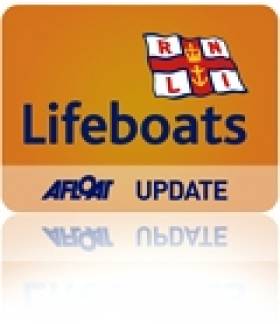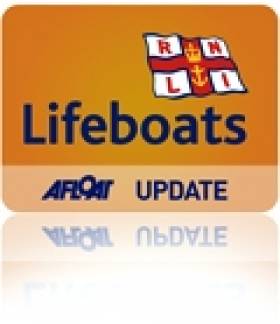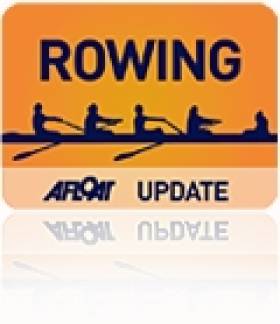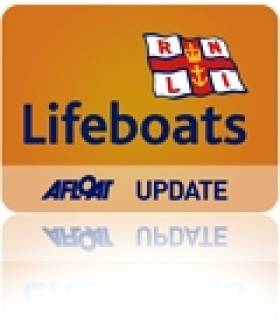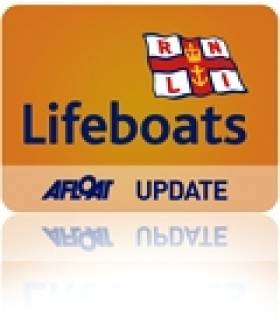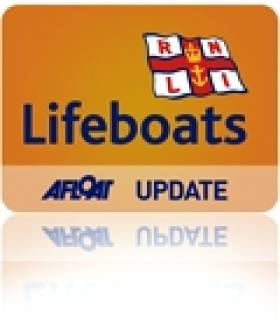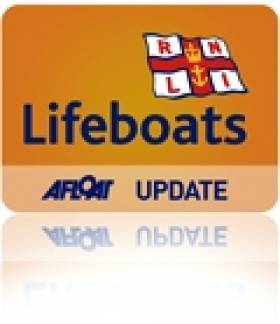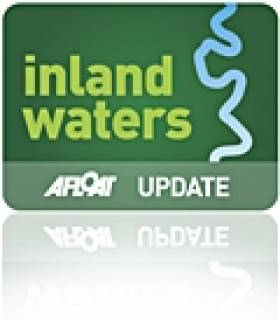Displaying items by tag: Enniskillen
#RNLI - The volunteer crew from Enniskillen RNLI lifeboat station launched their inshore lifeboat from Carrybridge at 9pm last night (Wednesday 6 May) to go to the assistance of a 32-foot sports cruiser.
The powerboat, with four adults on board, had run aground in Trial Bay about a mile from the Crom Estate public jetty.
The boat could not be refloated and the four people on board were transferred to the lifeboat with their personal belongings and brought back to Crom Estate.
#RNLI - The RNLI’s first permanent inland lifeboat station is now complete and fully operational on Upper Lough Erne in Co Fermanagh.
After been housed in temporary accommodation for 13 years, Enniskilllen RNLI volunteers were handed the keys to their new building in Carrybridge this week.
The modern purpose-built lifeboat station is located close to the lough to allow for an efficient launch of its inshore lifeboat and rescue water craft.
The station, which also houses the associated launching tractor and equipment, full crew changing facilities, a workshop, office and training room, will be officially opened later this year.
First announced nearly two years ago, the build took little over a year to complete was carried out by the Omagh based Woodvale Construction Company and handed over to the RNLI last Wednesday 25 March.
The building is designed with a heating system which allows the heat to be drawn from the ground and produced inside, keeping the temperature at an ambient 15 degrees Celsius. The excess is used to heat the water for showering, washing-up and cleaning the vessels. Solar panels on the roof will also generate electricity for the station's needs.
In order to facilitate the project, the local community helped the charity raise £60,000 towards the cost, which will now help the RNLI’s 40 volunteers based at Enniskillen to continue to save lives on Lough Erne.
In 2001, Enniskillen became home to the RNLI’s first inland lifeboat station based on Lower Lough Erne. Due to the overall size and complexity of the lough and its high leisure usage, the decision was taken by the RNLI in 2002 to base a second lifeboat on the Upper Lough at Carrybridge that would work in conjunction with the original lifeboat station on the Lower Lough at Killadeas.
With two bases, two inshore lifeboats and two rescue water craft, the station has since proved to be one of the busiest in Ireland.
Last year alone, Enniskillen RNLI launched 59 times, bringing 57 people to safety. Some 32 of those services were carried out in the dark while the crew spent 262 service hours on the water.
Speaking following the handover of the new building, RNLI divisional technical manager Derek Potter said he was delighted that the station was now complete.
"From the outset, we wanted to build a modern station with full crew facilities with areas for the crew to change and train and space to keep their lifeboat and rescue water craft and lifesaving kit safe," he said.
"We now have those facilities and are very happy to be in a position to take over the new lifeboat station and are delighted with both the design and quality of the building."
Enniskillen lifeboat operations manager Davey Robinson added that the new station was what the crew deserved.
"The new station is a testament to the RNLI’s commitment and dedication to the community here locally and a credit to our crews efforts in continuing to bring people to safety on Lough Erne," he said.
"Our volunteers had an opportunity to be shown around their new station this week and they are overwhelmed with the structure and facilities that they now have when they come together for callouts and training.
"We would like to thank everyone who has helped us to get to this stage including all those who donated, organised or participated in any fundraising activity."
Trinity Take the Honours at Erne Head of the River
#ROWING: Trinity’s men’s senior eight were the fastest crew at the Erne Head of the River in Enniskillen. They completed the 6,000 metre course in 18 minutes 22 seconds, eight seconds ahead of the senior eight from NUIG. The men’s heavyweight and lightweight senior eights entered by Rowing Ireland were divided by just one second, in fourth and fifth. The fastest women’s crew home were Trinity’s senior eight, with 34 seconds to spare over the Portora junior women’s eight.
Erne Head of the River, Enniskillen, Saturday
Overall: 1 Trinity senior eight 18 minutes 30 seconds, 2 NUIG sen eight 18:30, 3 Trinity intermediate eight 18:50, 4 Carlow, UCC, St Michael’s, Castleconnell, Killorglin sen eight 18:52, 5 Rowing Ireland lightweight eight 18:53, 6 Portora junior eight 18:58.
Men
Eight – Senior: Trinity 18:22. Inter: Trinity 18:50. Club One: Queen’s 19:06. Novice: Queen’s 20:57. Junior: Portora 18:58. Masters (Vet D): Neptune 21:57. Jun 16: St Joseph’s 20:44.
Four – Club One: Trinity (coxed). Jun 18: CAI (coxed) 22:07.
Sculling
Quadruple – Senior: Commercial 19:16. Inter: Sligo 22:10. Jun 18: Carlow A 21:12. Jun 16, coxed: Neptune 22:42.
Women
Eight – Senior: Trinity A 20:19. Club One: NUIG 21:12. Novice: Queen’s A 23:29. Jun 18: Portora 20:53. Masters: Belfast RC (Vet C) 23:56. Jun 16: Portora 22:54.
Four – Club One, coxed: Methody 23:26. Jun 18, coxed: Portora 24:32.
Sculling
Quadruple – Senior: Methody 23:30. Inter, coxed: Portora 25:06. Junior: Bann 21:50.
| 1 | 1 | DUBC | MS 8 | 18:22 | |||
|---|---|---|---|---|---|---|---|
| 2 | 2 | NUIG BC | MS 8 | 18:30 | |||
| 3 | 9 | DUBC | MI 8 | 18:50 | |||
| 4 | 4 | Carlow /UCC/SMRC/ Castleconnell/ Killorglin | MS 8 | 18:52 | |||
| 5 | 3 | Rowing Ireland LM | MS 8 | 18:53 | |||
| 6 | 10 | Portora BC | MJ 18 8 | 18:58 | |||
| 7 | 15 | QUBBC | MC 1 8 | 19:06 | |||
| 8 | 7 | Commercial RC | MS 4x- | 19:16 | |||
| 9 | 8 | Belfast RC | MI 8 | 19:24 | |||
| 10 | 5 | Rowing Ireland HM | MS 4x- | 19:27 | |||
| 11 | 11 | Bann RC | MJ 18 8 | 19:28 | |||
| 12 | 12 | St Josephs RC | MJ 18 8 | 19:46 | |||
| 13 | 17 | Methodist College | MC 1 8 | 19:49 | |||
| 14 | 6 | Skibb / Castleconnell/ UCC /Portadown | MS 4x- | 19:57 | |||
| 15 | 19 | DULBC A | WS 8 | 20:19 | |||
| 16 | 14 | NUIG BC | MC 1 8 | 20:21 | |||
| 17 | 42 | DUBC | MC 1 4+ | 20:41 | |||
| 18 | 26 | St Josephs RC | MJ 16 8 | 20:44 | |||
| 19 | 13 | Blackrock College | MJ 18 8 | 20:44 | |||
| 20 | 16 | DUBC | MC 1 8 | 20:51 | |||
| 21 | 20 | Portora BC | WJ 18 8 | 20:53 | |||
| 22 | 18 | RBAI | MC 1 8 | 20:55 | |||
| 23 | 37 | QUBBC A | MN 8+ | 20:57 | |||
| 24 | 25 | Portora BC A | MJ 16 8 | 21:02 | |||
| 25 | 28 | Carlow RC A | MJ 18 4x | 21:12 | |||
| 26 | 23 | NUIG BC | WC 1 8 | 21:12 | |||
| 27 | 38 | DUBC | MN 8+ | 21:18 | |||
| 28 | 29 | Methodist College | MJ 18 4x | 21:30 | |||
| 29 | 21 | DULBC B | WS 8 | 21:31 | |||
| 30 | 22 | QUBLBC | WC 1 8 | 21:37 | |||
| 31 | 44 | Bann RC | WJ 4x- | 21:50 | |||
| 32 | 40 | QUBBC C | MN 8+ | 21:53 | |||
| 33 | 30 | Neptune RC (VET D) | MM 8 | 21:57 | |||
| 34 | 34 | LVBC (VET E) | MM 8 | 22:03 | |||
| 35 | 33 | Belfast RC B (VET E) | MM 8 | 22:04 | |||
| 36 | 43 | CAI | MJ 18 4+ | 22:07 | |||
| 37 | 46 | Sligo RC | M I 4x | 22:10 | |||
| 38 | 36 | CAI | MJ 18 4x | 22:35 | |||
| 39 | 35 | Carlow RC B | MJ 18 4x | 22:41 | |||
| 40 | 48 | Neptune RC | MJ 16 4x+ | 22:42 | |||
| 41 | 50 | Portora BC A | WJ 16 8 | 22:54 | |||
| 42 | 57 | Portora BC B | MJ 16 8 | 22:55 | |||
| 43 | 24 | Belfast RC | WC 1 8 | 23:03 | |||
| 44 | 52 | Commercial RC | WJ 16 8 | 23:04 | |||
| 45 | 39 | QUBBC B | MN 8+ | 23:13 | |||
| 46 | 27 | CAI | MJ 16 8 | 23:15 | |||
| 47 | 41 | Molesey BC (VET G) | MM 8 | 23:19 | |||
| 48 | 47 | Methodist College | MJ 16 4x+ | 23:24 | |||
| 49 | 58 | Methodist College | WC 1 4+ | 23:26 | |||
| 50 | 51 | QUBBC A | WN 8 | 23:29 | |||
| 51 | 45 | Methodist College | WS 4x- | 23:30 | |||
| 52 | 55 | Belfast RC | WJ 18 4x- | 23:33 | |||
| 53 | 31 | Belfast RC A (VET E) | MM 8 | 23:45 | |||
| 54 | 49 | Belfast RC (VET C) | WM 8 | 23:56 | |||
| 55 | 59 | Portora BC | WJ 18 4+ | 24:32 | |||
| 56 | 53 | QUBBC B | WN 8 | 24:57 | |||
| 57 | 60 | Methodist College | WJ 18 4+ | 25:06 | |||
| 58 | 54 | QUBLBC | WI 4X+ | 25:06 | |||
| 59 | 62 | Portora BC B | WJ 16 8+ | 26:39 | |||
| 60 | 56 | Sligo RC | WJ 18 4x- | 26:46 | |||
| 61 | 32 | Portadown BC (VET E) | MM 8 | Did Not Row | |||
| 62 | 61 | Portora BC | MJ 16 4x+ | Did Not Row | |||
| 63 | 63 | Portora BC | WJ 18 4x- | Did Not Row | |||
| Masters Results by Handicap | |||||||
| Position | Crew Number | Club | Class | Time | Handicap | Final Time | |
| 1 | LVBC | MM 8 | E | 22:03 | 1:16 | 20:47 | |
| 2 | Belfast RC B | MM 8 | E | 22:04 | 1:16 | 20:48 | |
| 3 | Neptune RC | MM 8 | D | 21:57 | 0:53 | 21:04 | |
| 4 | Molesey BC | MM 8 | G | 23:19 | 2:10 | 21:09 | |
| 5 | Belfast RC A | MM 8 | E | 23:45 | 1:16 | 22:29 | |
| Portadown BC | MM 8 | E | Did Not Row | ||||
| 1 | Belfast RC (VET C) | WM8 | C | 23:56 | 00:35 | 24:31 |
#ROWING: Enniskillen club Portora bridged a gap back to 1980 when they won the junior men’s eights title at the Irish Rowing Championships at the National Rowing Centre in Cork today. St Joseph’s of Galway, seeking their third successive junior eights crown, fought it out with Portora down the course, but the boys in black and gold kept their heads impressively to pull away at the end.
The Gráinne Mhaol four of Fionnán Tolan, Alan Martin, Cormac Folan and James Wall beat Old Collegians to win the senior fours. The first half of the race was a nip-and-tuck battle, but the Galway crew moved away at 1250 metres to win well.
UCD and NUIG fought it out right to the finish in the women’s intermediate eights, with the Dublin college just shading it. UCD also won the inaugural men’s club eight – by almost eight seconds.
Justin Ryan gave UCC a title when he won the lightweight single sculls from Tim Harnedy of Skibbereen. The west Cork club added to their title roll by winning the junior women’s four.
Clonmel won the women’s novice coxed quadruple sculls from NUIG.
Irish Rowing Championships, National Rowing Centre, Cork (Selected Results, Finals)
Men
Eight – Club: 1 UCD 6:03.79, 2 Skibbereen 6:11.41, 3 Trinity B 6:13.04. Junior: 1 Portora 6:06.24, 2 St Joseph’s 6:10.21, 3 Bann 6:17.78.
Four – Senior: 1 Gráinne Mhaol 6:10.15, 2 Old Collegians 6:14.81.
Four, coxed – Intermediate: 1 NUIG 6:26.37, 2 Carlow 6:29.33, 3 Neptune 6:36.71.
Sculling, Quadruple – Novice, coxed: 1 Queen’s 6:49.52, 2 Clonmel 7:01.83, 3 Kenmare 7:17.56.
Double – Senior: 1 Skibbereen 6:30.22, 2 Three Castles 6:34.96, 3 UCC 6:45.32.
Single – Lightweight: 1 UCC (J Ryan) 7:26.61, 2 Skibbereen (T Harnedy) 7:31.73, 3 UCD (S Toland) 7:39.60.
Junior: 1 St Michael’s (D O’Malley) 7:17.53, 2 Shannon (C Carmody) 7:22.81, 3 Waterford (A Goff) 7:25.24.
Women
Eight – Intermediate: UCD 6:44.30, 2 NUIG 6:44.92, 3 Queen’s 6:55.60.
Four – Senior: 1 NUIG/Cork 6:57.92, 2 Trinity 7:09.18, 3 Skibbereen 7:16.93. Junior Four: 1 Skibbereen 7:18.45, 2 Muckross 7:29.03, 3 Shannon 7:31.07.
Four, coxed – Club: 1 NUIG A 7:25.50, 2 UCC 7:33.87, 3 Skibbereen 7:38.30.
Pair – Intermediate: 1 St Michael’s 7:49.72, 2 Trinity 7:53.27, 3 Shannon 7:53.29.
Sculling,
Quadruple – Novice, coxed: 1 Clonmel 7:47.42, 2 NUIG 8:03.81, 3 Athlunkard 8:48.81.
Double – Junior: 1 Cork 7:26.87, 2 Belfast 7:32.25, 3 Commercial 7:36.33.
#RNLI - Some 46 people completed the 750m course on Lough Erne in the revived Castle Island Charity Swim recently - including three Enniskillen RNLI lifeboat crew in full kit!
As reported last month on Afloat.ie, the swim traditionally took place annually with the support of the Blake family, and Enniskillen RNLI hailed as a "great honour" the chance to bring back the annual event.
Apart from the action on the water on Sunday 11 August, the day featured was a family fun morning on shore with a bouncy castle, face painting and an ice cream stand.
Lifeboat volunteer crewman Adrian Kelly said of the day: "I would like to take this opportunity to thank everyone who got involved on all levels. I really hope everyone enjoyed the event and that we can give it a go next year."
#RNLI - Enniskillen RNLI will host the revived Castle Island charity swim and family fun morning in Enniskillen, Co Fermanagh on Sunday 11 August.
The swim traditionally took place each year with the support of the Blake family.
And Enniskillen RNLI have hailed as a "great honour" the opportunity for its local volunteer crew to revive the swim in association with sponsors Blakes the Hollow, Western Cars and The Print Factory.
The 750m swim on Lough Erne is open to swimmers of all ages either individually or in small groups such as youth clubs, sports clubs or simply groups of friends.
Enniskillen RNLI says the emphasis for this swim is for everyone to have fun and for that reason, if required, novice swimmers may complete the swim in a well-fitted lifejacket or buoyancy aid but must be confident that they can complete the distance.
Lifeboat crew not swimming themselves will also be present on the day to provide safety cover for the event.
Registration for the swim will take place at 12 noon on the day, followed by a short safety briefing. Sponsorship forms are available by email or can be collected at The Wig & Crown, Blakes the Hollow and Western Cars. For further information contact Adrian at 07974 730456.
In other news, RTÉ Radio 1’s The Business will broadcast live from Bundoran RNLI lifeboat station this Saturday morning 3 August.
The focus of the show will be on the business of Bundoran being a seaside resort - a reputation the Donegal town has enjoyed for more than two centuries.
Speaking ahead of his visit, programme host George Lee said: "I'm really looking forward to broadcasting from Bundoran, particularly on a bank holiday weekend. I'm hoping to experience lots of surfing, slots machines and ice-creams.
"On the show we'll be looking back at the heyday of the dancehalls, we'll be joined by Bundoran regular Ramona Nicholas from Dragon's Den, we'll be speaking to two men making money from oil exploration and lots, lots more."
The Business is broadcast Saturday morning at 10am on RTÉ Radio 1.
#RNLI - Enniskillen RNLI today (10 June) brought four people to safety in two separate incidents on Lough Erne in Co Fermanagh.
In the first call-out of the day, the volunteer lifeboat crew retrieved a man and women from their stranded cruiser which had developed engine problems and run aground on Lower Lough Erne.
The inshore lifeboat Joseph and Mary Hiley and the Rescue Water Craft (RWC) were launched just before 10am at the request of Belfast Coastguard and made the 25-minute, six-mile journey to the casualty's last known position at Crunnish Island. The wind was coming from the south east, force five with good visibility.
On arrival at the scene, the crew noted the casualties had deployed their anchor and there were strong waves hitting the starboard side of the vessel.
The RWC crew member was transferred to the casualty vessel to reassure the crew and to check for any leakage. Another crew member from the lifeboat was transferred to assist with the tow and to lift the anchor.
The lifeboat established a tow and the vessel was refloated and brought to safety at Tudor Farm jetty, close to the initial location.
Less than three hours later, the inshore lifeboat Jason Logg was launched by request of Belfast Coastguard to rescue two people on a broken-down personal water craft on Upper Lough Erne.
The crew proceeded to the casualty's last known whereabouts at the mouth of Tamlagh Bay, four miles downstream from the station towards Enniskillen.
On arrival, the crew found the troubled vessel in the reeds with two people sitting on it. The crew transferred both passengers onto the lifeboat before setting up a tow and bringing the water craft back to Bellanaleck Marina.
Elsewhere in Northern Ireland, Portaferry RNLI brought three men and a teenage boy to safety yesterday afternoon after their yacht got into difficulty off Portaferry in Co Down.
The volunteer lifeboat crew was alerted just after noon following a mayday call that there was a demasted yacht in trouble on Strangford Lough.
The lifeboat was launched minutes later and was alongside the stricken vessel, a 37ft yacht located in the narrows of Strangford Lough, at 12.10pm. Weather at the time was good with clear visibility and a flat calm sea.
One of the four casualties, who had been thrown from the vessel, had been recovered by a fellow crew member and all four were on board the yacht when the lifeboat crew arrived on scene.
Alongside, there was difficulty recovering the vessel so the mast and sail were cut away. Once cut, the lifeboat proceeded to tow the yacht with it crew on board safely back to Strangford where it was tied to a mooring.
Two of the crew were conveyed to hospital while the other two were made comfortable on the shore.
Portaferry RNLI was requested to launch for a second time later this afternoon following a report that a swimmer had gone missing in Newtownards. The lifeboat having launched was subsequently stood down after the missing person was found safe and well.
#RNLI - Kilrush RNLI in Co Clare was diverted from exercise training on Tuesday 28 May when the lifeboat came to the assistance of a 10ft boat.
The volunteer lifeboat crew at Kilrush were returning from their weekly training exercise at 8.45pm when they were requested to go in search of a vessel that had lost its moorings at Tarbert pier.
After relaying the situation to the Coast Guard at Valentia and getting permission to launch, the inshore lifeboat Edith Louise Eastwick set off to the Tarbert area and carried out an extensive search. Weather conditions at the time were blowing force three to four northerly winds.
The crew continued eastwards and crossed over to the Labasheeda region where they located the 10ft punt off Kilkerrin Point.
After securing the vessel to the lifeboat, the crew brought it back to Tarbert pier where the owners were waiting. The vessel was handed over and a request that a new mooring line be put in place was made.
The call out was crew member Charlie Glynn’s first as helm, having secured the position a month ago.
Earlier that day, Enniskillen RNLI was launched to reports of a cruiser which had run aground on Lower Lough Erne in Co Fermanagh.
The volunteer crew on their inshore lifeboat Joseph and Mary Hiley and the Rescue Water Craft (RWC) proceeded to Inish Davar, two miles from the station. Weather at the time was clear with calm waters.
The crew arrived at the location to find the owner of the vessel on another boat and assisting the casualty boat and the two men and two women who were on board and safe and well. The lifeboat crew stood off and observed from a distance.
New Lifeboat Station For Upper Lough Erne
#RNLI - Enniskillen RNLI is to get a new lifeboat station at its Carrybridge base on Upper Lough Erne, it has emerged.
Planning permission for the new build has been passed by Fermanagh District Council and the RNLI’s tendering process is now underway, with a view for building work to commence in late summer.
Once complete, the modern station - much like the new facility for Castletownbere RNLI that opened recently - will replace the existing temporary accommodation which has housed the charity’s volunteer lifeboat crew for the past 11 years.
In order to facilitate the project, the local community is being asked to help the RNLI raise £60,000 (€70,000) towards the cost, which will help Enniskillen RNLI continue to save lives on Lough Erne.
In 2001, Enniskillen became home to the RNLI’s first inland lifeboat station based on Lower Lough Erne.
Due to the overall size and complexity of the lough and its high leisure usage, the decision was taken by the RNLI in 2002 to base a second lifeboat on the upper lough that would work in conjunction with the original lifeboat station on the lower lough.
With two bases, two inshore lifeboats and two rescue water craft, the station has since proved to be one of the busiest in Ireland.
Last year alone, Enniskillen RNLI launched 46 times bringing 50 people to safety. Some 20 of those services were carried out in the dark while the crew spent 169 service hours on the water.
RNLI divisional operations manager Gareth Morrison said he was delighted that planning had now been approved making way for what will be a purpose-built station in a location close to the lough allowing for an efficient launch.
"In an area that receives over 100 days of heavy rainfall a year, it is hard to believe the volunteer crew based at the upper lough operate from just a temporary facility, partly exposed to the elements," said Morrison.
"The crew has to change in a small, damp, metal container and only has a portaloo and wash basin for their comfort. There is nowhere for the crew to shower or dry after a challenging rescue and nowhere for them to gather and train together during the week.
"We want to build a modern station with full crew facilities with areas for the crew to change and train and space to keep their lifeboat and rescue water craft and lifesaving kit safe."
Enniskillen RNLI lifeboat operations manager Davey Robinson said a new station was what the crew deserved.
"At the moment we are operating out of a temporary facility. It is cramped and there are no showers so the crew cannot warm up after a cold, wet and tiring rescue. A new station will be great for the crew. We are a busy station so it is what they deserve."
He added: "It is always reassuring for locals and visitors alike that the RNLI is here to assist them or help their loved ones when they get into difficulty. We try to act as a safety net on Lough Erne and are here 24 hours a day. But we need the right facilities to do that and this new station will help."
Donations and other assistance with fundraising are welcome. For details contact Tony Hiney, RNLI community fundraising manager, at 087 219 8917 or email [email protected].
#InlandWaterways - Waterways Ireland has advised all masters and users of the Erne system that the channel east of Castle Island near Enniskillen will be closed till Tuesday 11 June to facilitate a number of events on the water.
Mariners are directed to follow the marked navigation channel and signs to the west of Castle Island and proceed at a slow speed and with minimum wash. They should note any advise or instructions given by event organisers when in this section of the navigation.
Public jetties in the vicinity will remain accessible throughout, though some minor restrictions may be in place as and when required. Further information is available from the Lough Erne warden at 028 6632 3004.
Elsewhere, there will also be restricted mooring for masters and owners on the River Shannon at Carrick-on-Shannon to facilitate spectator viewing of the Carrick 400 event.
On Sunday 2 June the quay wall from the downstream face of the town bridge to the floating moorings will be out of bounds for mooring from 7pm till midnight.
In other waterways news, recent water quality testing has shown the harbour at Kilcock on the Royal Canal to now be within normal bathing water standards.





























